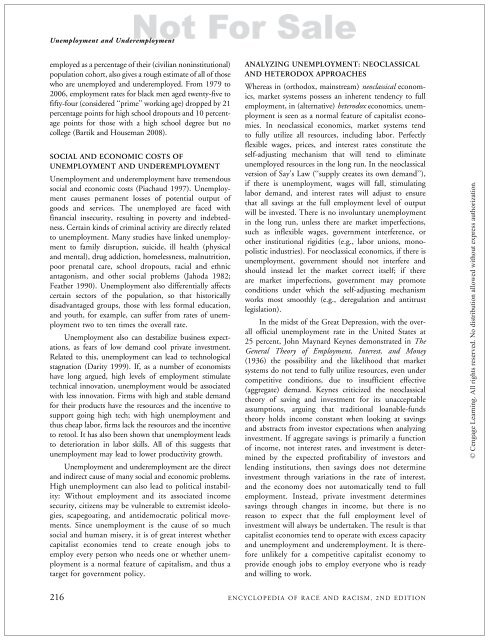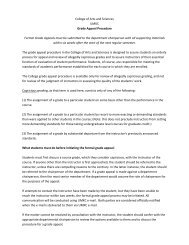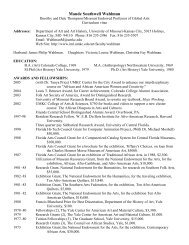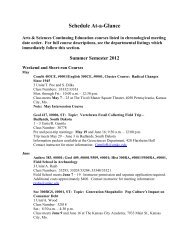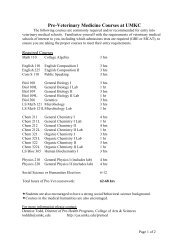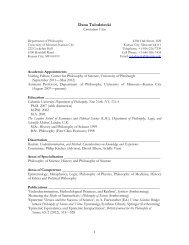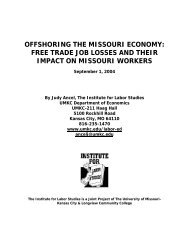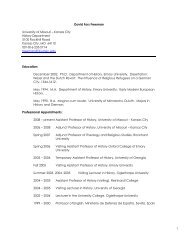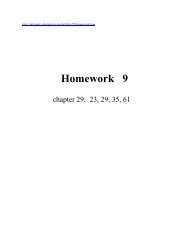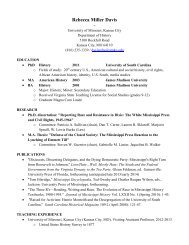Unemployment and Underemployment - College of Arts & Sciences
Unemployment and Underemployment - College of Arts & Sciences
Unemployment and Underemployment - College of Arts & Sciences
Create successful ePaper yourself
Turn your PDF publications into a flip-book with our unique Google optimized e-Paper software.
Encyclopedia <strong>of</strong> Race <strong>and</strong> Racism, 2nd Edition, Volume 4 – 4th/ 11/30/2012 11:53 Page 216<br />
<strong>Unemployment</strong> <strong>and</strong> <strong>Underemployment</strong><br />
employed as a percentage <strong>of</strong> their (civilian noninstitutional)<br />
population cohort, also gives a rough estimate <strong>of</strong> all <strong>of</strong> those<br />
who are unemployed <strong>and</strong> underemployed. From 1979 to<br />
2006, employment rates for black men aged twenty-five to<br />
fifty-four (considered ‘‘prime’’ working age) dropped by 21<br />
percentage points for high school dropouts <strong>and</strong> 10 percentage<br />
points for those with a high school degree but no<br />
college (Bartik <strong>and</strong> Houseman 2008).<br />
SOCIAL AND ECONOMIC COSTS OF<br />
UNEMPLOYMENT AND UNDEREMPLOYMENT<br />
<strong>Unemployment</strong> <strong>and</strong> underemployment have tremendous<br />
social <strong>and</strong> economic costs (Piachaud 1997). <strong>Unemployment</strong><br />
causes permanent losses <strong>of</strong> potential output <strong>of</strong><br />
goods <strong>and</strong> services. The unemployed are faced with<br />
financial insecurity, resulting in poverty <strong>and</strong> indebtedness.<br />
Certain kinds <strong>of</strong> criminal activity are directly related<br />
to unemployment. Many studies have linked unemployment<br />
to family disruption, suicide, ill health (physical<br />
<strong>and</strong> mental), drug addiction, homelessness, malnutrition,<br />
poor prenatal care, school dropouts, racial <strong>and</strong> ethnic<br />
antagonism, <strong>and</strong> other social problems (Jahoda 1982;<br />
Feather 1990). <strong>Unemployment</strong> also differentially affects<br />
certain sectors <strong>of</strong> the population, so that historically<br />
disadvantaged groups, those with less formal education,<br />
<strong>and</strong> youth, for example, can suffer from rates <strong>of</strong> unemployment<br />
two to ten times the overall rate.<br />
<strong>Unemployment</strong> also can destabilize business expectations,<br />
as fears <strong>of</strong> low dem<strong>and</strong> cool private investment.<br />
Related to this, unemployment can lead to technological<br />
stagnation (Darity 1999). If, as a number <strong>of</strong> economists<br />
have long argued, high levels <strong>of</strong> employment stimulate<br />
technical innovation, unemployment would be associated<br />
with less innovation. Firms with high <strong>and</strong> stable dem<strong>and</strong><br />
for their products have the resources <strong>and</strong> the incentive to<br />
support going high tech; with high unemployment <strong>and</strong><br />
thus cheap labor, firms lack the resources <strong>and</strong> the incentive<br />
to retool. It has also been shown that unemployment leads<br />
to deterioration in labor skills. All <strong>of</strong> this suggests that<br />
unemployment may lead to lower productivity growth.<br />
<strong>Unemployment</strong> <strong>and</strong> underemployment are the direct<br />
<strong>and</strong> indirect cause <strong>of</strong> many social <strong>and</strong> economic problems.<br />
High unemployment can also lead to political instability:<br />
Without employment <strong>and</strong> its associated income<br />
security, citizens may be vulnerable to extremist ideologies,<br />
scapegoating, <strong>and</strong> antidemocratic political movements.<br />
Since unemployment is the cause <strong>of</strong> so much<br />
social <strong>and</strong> human misery, it is <strong>of</strong> great interest whether<br />
capitalist economies tend to create enough jobs to<br />
employ every person who needs one or whether unemployment<br />
is a normal feature <strong>of</strong> capitalism, <strong>and</strong> thus a<br />
target for government policy.<br />
ANALYZING UNEMPLOYMENT: NEOCLASSICAL<br />
AND HETERODOX APPROACHES<br />
Whereas in (orthodox, mainstream) neoclassical economics,<br />
market systems possess an inherent tendency to full<br />
employment, in (alternative) heterodox economics, unemployment<br />
is seen as a normal feature <strong>of</strong> capitalist economies.<br />
In neoclassical economics, market systems tend<br />
to fully utilize all resources, including labor. Perfectly<br />
flexible wages, prices, <strong>and</strong> interest rates constitute the<br />
self-adjusting mechanism that will tend to eliminate<br />
unemployed resources in the long run. In the neoclassical<br />
version <strong>of</strong> Say’s Law (‘‘supply creates its own dem<strong>and</strong>’’),<br />
if there is unemployment, wages will fall, stimulating<br />
labor dem<strong>and</strong>, <strong>and</strong> interest rates will adjust to ensure<br />
that all savings at the full employment level <strong>of</strong> output<br />
will be invested. There is no involuntary unemployment<br />
in the long run, unless there are market imperfections,<br />
such as inflexible wages, government interference, or<br />
other institutional rigidities (e.g., labor unions, monopolistic<br />
industries). For neoclassical economics, if there is<br />
unemployment, government should not interfere <strong>and</strong><br />
should instead let the market correct itself; if there<br />
are market imperfections, government may promote<br />
conditions under which the self-adjusting mechanism<br />
works most smoothly (e.g., deregulation <strong>and</strong> antitrust<br />
legislation).<br />
In the midst <strong>of</strong> the Great Depression, with the overall<br />
<strong>of</strong>ficial unemployment rate in the United States at<br />
25 percent, John Maynard Keynes demonstrated in The<br />
General Theory <strong>of</strong> Employment, Interest, <strong>and</strong> Money<br />
(1936) the possibility <strong>and</strong> the likelihood that market<br />
systems do not tend to fully utilize resources, even under<br />
competitive conditions, due to insufficient effective<br />
(aggregate) dem<strong>and</strong>. Keynes criticized the neoclassical<br />
theory <strong>of</strong> saving <strong>and</strong> investment for its unacceptable<br />
assumptions, arguing that traditional loanable-funds<br />
theory holds income constant when looking at savings<br />
<strong>and</strong> abstracts from investor expectations when analyzing<br />
investment. If aggregate savings is primarily a function<br />
<strong>of</strong> income, not interest rates, <strong>and</strong> investment is determined<br />
by the expected pr<strong>of</strong>itability <strong>of</strong> investors <strong>and</strong><br />
lending institutions, then savings does not determine<br />
investment through variations in the rate <strong>of</strong> interest,<br />
<strong>and</strong> the economy does not automatically tend to full<br />
employment. Instead, private investment determines<br />
savings through changes in income, but there is no<br />
reason to expect that the full employment level <strong>of</strong><br />
investment will always be undertaken. The result is that<br />
capitalist economies tend to operate with excess capacity<br />
<strong>and</strong> unemployment <strong>and</strong> underemployment. It is therefore<br />
unlikely for a competitive capitalist economy to<br />
provide enough jobs to employ everyone who is ready<br />
<strong>and</strong> willing to work.<br />
216 ENCYCLOPEDIA OF RACE AND RACISM, 2ND EDITION


